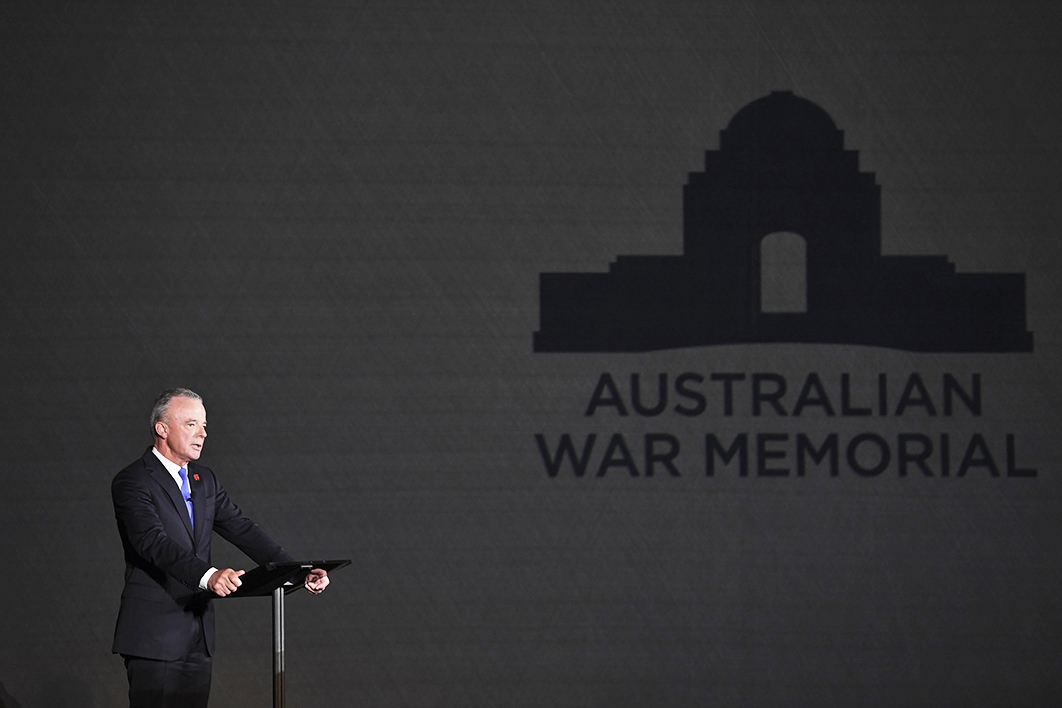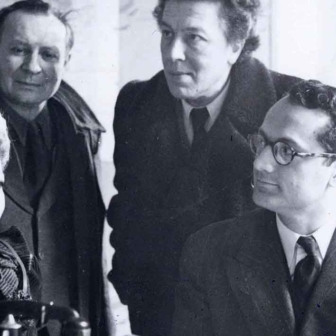The Australian War Memorial and its embarrassing director Brendan Nelson are getting some of what they deserve, but only some. The AWM’s (successful) bid for half a billion public dollars to house its tribute to those who have served and died in conflicts since the second world war has provoked hostile commentary, culminating in Jack Waterford’s splendid takedown of Nelson, the AWM and its outrageous raid on the public purse in the Canberra Times. But with some exceptions (here, here, and here) this commentary, including Waterford’s, has followed the AWM itself in missing the main point: the failure to recognise what are by any measure the most sustained, costly and disastrous of Australia’s wars, the so-called “frontier” wars, deadly conflicts between black and white that went on for well over a century.
Waterford’s free character reference for Nelson — including his “genius for turning every story about the memorial and the World War I celebrations into a story about himself” — is best enjoyed in full. His case against the AWM and its half-billion spend can be summarised as follows:
• The AWM’s expansion plans lack proportionality. Australian involvement and casualties in wars in Korea, Vietnam, Afghanistan and elsewhere, now to be memorialised by the AWM, are dwarfed by the two world wars. Of those whose names are inscribed at the memorial, Waterford points out, 99 per cent were killed before 1950. There were many single days during the first world war when more Australian soldiers died than have been killed since 1950.
• A proportional comparison is even more striking. Were we to experience today losses proportionate to those of the Great War, 400,000 would die and 800,000 would become invalids.
• Service and sacrifice must be recognised, but so must the facts. Australia made significant contributions to the outcomes of the world wars. These were provided overwhelmingly by volunteers, not professionals, and they paid a high price. The entire population was mobilised in a widely supported cause. None of these things can be said of the post-1950 conflicts.
Waterford concludes his assault on the AWM and its proposal with some thoughts about how the $500 million could be better spent, but he (with other commentators) misses the obvious option: the money should be spent on recognising the frontier wars.
To justify that suggestion, I will borrow Waterford’s methodology:
• The number of deaths from violence on Australia’s frontiers exceeded the number of Australian deaths in the first world war and was probably close to double the number of second world war casualties.
• Were we — I speak as a non-Indigenous Australian — to experience a similar casualty rate now, somewhere between two and three million would die.
• Numbers of deaths by violence on the frontiers were greatly exceeded by deaths from disease, malnutrition and addictive substances, variously preceding, accompanying and following frontier violence. An Aboriginal population estimated at three quarters of a million or more when the first fleet arrived had been reduced to less than one-tenth of that number by the 1920s.
• An entire civilisation came close to complete destruction, as did much of the ecology that sustained it, exacting a further toll of physical and psychological misery that still has a long way to run.
These figures for violent deaths no doubt raise some eyebrows, and need to be explained.
Historians have struggled with the calculation for decades. Generally speaking, the more recent the estimate, the greater the figure arrived at. By the turn of the century Henry Reynolds’s early estimate of 20,000 was regarded as very conservative. For example, in his Claiming a Continent (1996), David Day speculated that the true number might approach Australian losses in the first world war.
All this went out the window when Raymond Evans, a noted historian of the frontiers, joined with the Danish scholar Robert Ørsted-Jensen and built on pioneering research by Jonathan Richards to detail the activities and consequences of the notorious Queensland Native Police, or QNP, long hidden from view by the destruction and dispersal of the relevant records.
Richards and then Evans and Ørsted-Jensen tracked down and employed such evidence as had survived to work out numbers of QNP patrols per year and numbers of deaths per patrol. Evans and Ørsted-Jensen report a total of 3420 “official dispersals” by the QNP, resulting in more than 40,000 Aboriginal deaths. They further examined evidence about confrontations between settlers and Aborigines and concluded that 275 conflicts contributed a further 20,000-plus deaths. Adding “invader” deaths and estimates of casualties before their period of study (1859–98), Evans and Ørsted-Jensen arrived at an estimated total for Queensland in excess of 66,000 and a ratio of Aboriginal to white deaths of 44–1. These estimates, they insist, are “cautious [and] minimal.”
Violent deaths on other Australian frontiers are usually estimated at between 10,000 and 20,000, with a ratio of Aboriginal to white deaths of perhaps 10–1. The much lower figures reflect the dense Aboriginal population of Queensland, the lesser impact of disease there, and the fact that most of the Queensland frontiers came after the invention of repeating rifles and the refinement of methods and tactics, including the use of mounted Aboriginal troopers recruited from previously defeated peoples.
Of course there are various sophistries available to the AWM and others to argue that these events did not constitute “war,” and it is true that there was no declaration of war, that the combatants were not in the armed forces and/or Australian, and so on and so forth. But there is now a consensus among military historians, echoing what was widely assumed to be the case in the nineteenth century: frontier conflict was indeed warfare, pursued in distinctively Australian ways.
The hard question is this: what explains the AWM’s refusal to see these wars as wars? And harder still, what explains the fact that even a distinguished journalist such as Jack Waterford didn’t think to include them either or, perhaps, did think of it and decided against? And, for that matter, what explains the fact that Evans and Ørsted-Jensen’s work and findings, which should have created a national stir when published in 2014, are still known only to the cognoscenti?
There is a certain perverse rationality to the AWM’s obscurantism, doggedly maintained for more than forty years — ever since 1979, in fact, when none other than Geoffrey Blainey was the first of many historians to suggest that the frontier wars might be included. To give them parity with other wars involving Australians would not sit well with the AWM’s even longer campaign to manufacture, promote and profit from an Anzac mystique.
But Waterford belongs to an entirely different mental world from that inhabited by Brendan Nelson and his predecessor and the many AWM council members who have tagged along behind them. So what does his silence signify?
Anyone who has puzzled over these things is in debt, conscious or otherwise, to the great anthropologist and public intellectual W.E.H. Stanner. In the second of his celebrated 1968 Boyer lectures, Stanner pointed to something previously unnoticed, the “great Australian silence,” a silence that reigned over “relations between two racial groups within a single field of life.”
“It is a structural matter,” Stanner argued, “a view from a window which has been carefully placed to exclude a whole quadrant of the landscape. What may have begun as a simple forgetting of other possible views turned under habit and over time into something like a cult of forgetfulness practised on a national scale.”
There has since been a torrent both of storytelling, and of conflict over whether and how the stories should be told. Dozens of historians and others, led by the heroic Henry Reynolds, have worked to break that silence at its centre so that we accept two things: that we are the beneficiaries of a past that includes both honourable sacrifice in honourable causes (including particularly those for which the AWM was conceived and created) and brutal, sustained and deeply dishonourable violence against peoples almost powerless to resist. The first is central to our way of thinking about who we are; the second is peripheral at best. The case to be made against the AWM is that it is wilfully, culpably wrong about both. •




